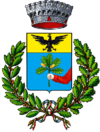Monghidoro
| Monghidoro | ||
|---|---|---|
| Comune | ||
| Comune di Monghidoro | ||
|
||
| Location of Monghidoro in Italy | ||
| Coordinates: 44°13′N 11°19′E / 44.217°N 11.317°ECoordinates: 44°13′N 11°19′E / 44.217°N 11.317°E | ||
| Country | Italy | |
| Region | Emilia-Romagna | |
| Province / Metropolitan city | Bologna (BO) | |
| Frazioni | see list | |
| Government | ||
| • Mayor | Barbara Panzacchi | |
| Area | ||
| • Total | 48.2 km2 (18.6 sq mi) | |
| Elevation | 841 m (2,759 ft) | |
| Population (30 June 2010) | ||
| • Total | 3,891 | |
| • Density | 81/km2 (210/sq mi) | |
| Demonym(s) | Monghidoresi | |
| Time zone | CET (UTC+1) | |
| • Summer (DST) | CEST (UTC+2) | |
| Postal code | 40063 | |
| Dialing code | 051 | |
| Website | Official website | |
Monghidoro is a comune (municipality) in the Province of Bologna in the Italian region of Emilia-Romagna, located about 41 kilometres (25 mi) south of Bologna.
The territory of Monghidoro borders the following municipalities: Firenzuola, Loiano, Monterenzio, Monzuno, San Benedetto Val di Sambro.
The town sits on a ridge of the Apennines, between two river valleys, Savena and Idice. The main road, joining Bologna to Florence, is the SP65. Traces of a Roman road, Flaminia minor, joining Florentia with Felsina can still be found at the top of Mount Oggioli, approximately 8 kilometres (5 mi) south of town.
The territory surrounding the comune is, for the largest part, mountainous with elevations ranging between a minimum of 400 metres (1,300 ft) above sea level to the north-east to a maximum of 1,290 metres (4,230 ft) on its southern flank.
Due to its geographical position Monghidoro, which the writer Giordano Berti has described as the "Crossroads of Europe", in the course of the centuries became a necessary passage between the Po Valley and Central Italy.
The name of Monghidoro is thought to be dating back to the times the Ostrogoths, Byzantines, Langobards, who were pillaging and looting at will up and down the Italian peninsula around the 8th, 9th century AD. It is believed that a Gothic settlement lasted long enough to give its name to the locality of Mons Gothorum (Goths' Mountain), but another theory links the name to "Mungi d'oro" (Golden Milking, in Italian), perhaps connected to the many green pastures that abound in the surrounding area.
The town, in its current form, originated in 1264 when the commune of Bologna created a vanguard here to counter the expansion of the Republic of Florence and in 1246, as a result of the complex politics of Italian city states of that period, the village was fortified to counter the continued border skirmishes and was given the nickname of “Scaricalasino” which literally translates as “unload the donkey”; this because the village sits at the top of a harsh ascent, which takes the traveller from 598 m to 841 m and it was indispensable to rest the beasts of burden following the climb.
...
Wikipedia


